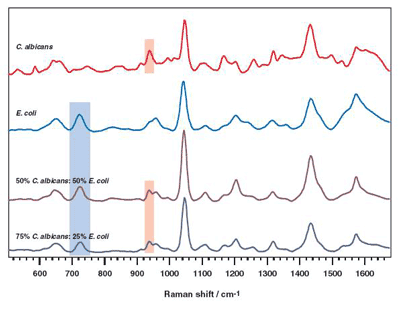What is Surface-Enhanced Raman Scattering?
Raman signals are inherently weak, especially when using visible light excitation and so a low number of scattered photons are available for detection. One method to amplify weak Raman signals is to employ surface-enhanced Raman
scattering (SERS). SERS uses nanoscale roughened metal surfaces typically made of gold (Au) or silver (Ag). Laser excitation of these roughened metal nanostructures resonantly drives the surface charges creating a highly localized
(plasmonic) light field. When a molecule is absorbed or lies close to the enhanced field at the surface, a large enhancement in the Raman signal can be observed. Raman signals several orders of magnitude greater than normal
Raman scattering are common, thereby making it possible to detect low concentrations (10-11) without the need for fluorescent labeling. The Raman signal can be amplified further when the roughened metal surface is used in combination
with laser light that is matched to the absorption maxima of the molecule. This effect is known as surface-enhanced resonance Raman scattering, (SERRS).

Figure 1: Conceptual illustration of SERS.
SERS is finding increasing use in a variety of applications ranging from:
- Basic analytical chemistry testing
- Drug discovery
- Forensic field testing
- Detecting of trace amounts of chemical and biological threat agents
- Point-of-care (POC) medical diagnostic devices

Figure 2: Example of SERS: SERS spectra from pure C. albicans, pure E. coli, and mixtures of the two. Characteristics peaks are indicated by the shaded boxes. Courtesy of Renishaw Diagnostics.
Learn more about surface-enhanced Raman scattering:
Raman microscopy and surface-enhanced Raman scattering (SERS) for in situ analysis of biofilms
Journal of Biophotonics
Surface micropatterning technique for surface-enhanced Raman scattering analysis
Journal of Analytical Methods



